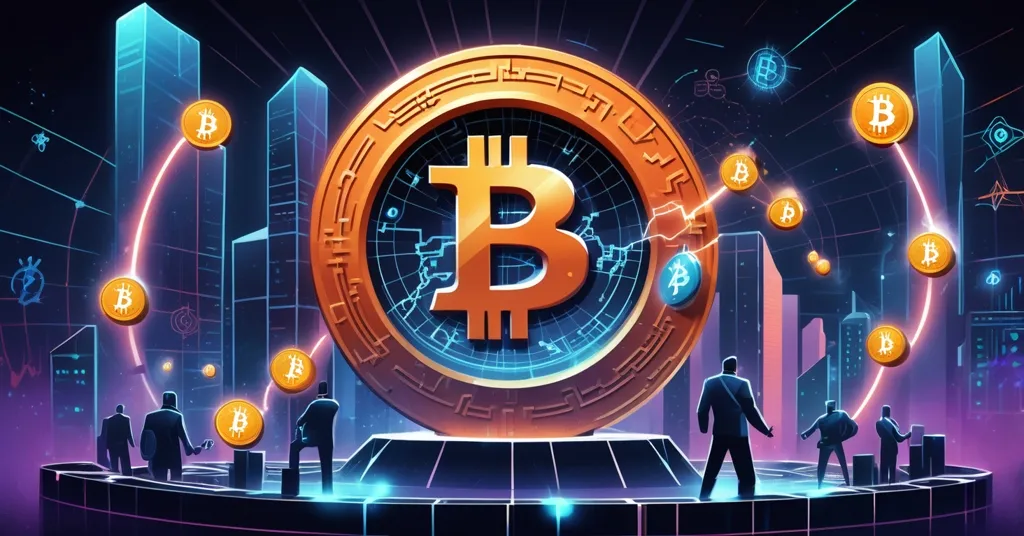XRP ETF Buzz, Western Union’s Solana Play, and Hoskinson-Schiff Clash: Crypto Weekly Highlights

Weekly Crypto Roundup: XRP ETF on the Horizon, Western Union’s Solana Gamble, and Hoskinson’s Jab at Schiff
Buckle up, crypto fans—another week of seismic shifts and sharp exchanges has unfolded in the digital asset realm. From a potential XRP ETF launch that could bridge altcoins to Wall Street, to Western Union’s bold leap into stablecoins on Solana, and a fiery clash between Cardano’s founder and a notorious Bitcoin skeptic, there’s no shortage of action as decentralization continues to challenge the old guard.
- XRP ETF Nears Launch: Canary Funds targets November 13, pending SEC green light.
- Western Union’s Blockchain Move: Solana-based stablecoin USDPT slated for 2026.
- Hoskinson Slams Schiff: Cardano founder mocks Bitcoin critic’s failed price calls.
- Uphold’s Crypto Loans: Digital asset-backed lending kicks off in Florida this December.
- XRP/BTC Stalemate: Trading pair awaits breakout amid market uncertainty.
XRP ETF: A Mainstream Milestone?
A potential game-changer for altcoin adoption is brewing as Canary Funds pushes forward with a spot XRP ETF. They’ve updated their S-1 filing with the Securities and Exchange Commission (SEC), a critical document akin to a pre-approval application before a financial product hits the market. The tentative launch date is set for November 13, bolstered by the ETF’s recent listing with the Depository Trust & Clearing Corporation (DTCC), which handles the backend for securities trading. Think of DTCC’s involvement as a stamp of readiness for mainstream exchanges. However, hurdles remain—SEC approval isn’t guaranteed, especially given the agency’s historical skepticism toward crypto products beyond Bitcoin and Ethereum. Nasdaq’s Form 8-A filing, another regulatory checkbox, is also pending. If this ETF clears the gauntlet, it could channel institutional money into XRP, mirroring the success of BTC and ETH ETFs that have already drawn billions. For those new to the space, an ETF is a stock-like product that tracks an asset’s price, letting investors gain exposure to XRP without wrestling with wallets or private keys. It’s a doorway for traditional finance to dip into crypto without getting their hands dirty.
Let’s not kid ourselves, though—the road to approval is a minefield. XRP’s ongoing legal saga with the SEC, stemming from a 2020 lawsuit over whether it’s a security, still casts a shadow. Even with a partial victory for Ripple (XRP’s parent company) in 2023, where a judge ruled secondary sales aren’t securities, regulatory headwinds persist. Past altcoin ETF rejections, like those for smaller tokens, show the SEC’s reluctance to embrace anything beyond the top dogs. On the flip side, Bitcoin’s ETF success has softened the ground—analysts speculate a spot XRP ETF could pull in hundreds of millions in inflows within months if approved. Still, we’re not holding our breath. The SEC could drag its feet with comments or outright denials, and a delay past November 13 wouldn’t shock anyone. Could this be the moment altcoins like XRP finally get their Wall Street debut, or just another false start?
Western Union’s Blockchain Gamble: Solana Stablecoin by 2026
In a surprising pivot, Western Union, the Denver-based financial titan serving 100 million customers across over 200 countries, is diving into blockchain with a Solana-based stablecoin named U.S. Dollar Payment Token (USDPT), targeted for 2026. CEO Devin McGranahan framed this as a pivotal move, stating:
“This Solana-based stablecoin project marks the next chapter in Western Union’s legacy of financial innovation.”
The logic is straightforward. Remittances, Western Union’s bread and butter, often carry hefty fees—averaging 5-7% per transaction—and sluggish processing times. Blockchain offers a fix with near-instant, low-cost transfers. Solana, a high-speed blockchain known for transactions costing pennies and processing thousands per second, seems a natural fit for handling cross-border micropayments at scale. For newcomers, a stablecoin is a digital currency pegged to a stable asset like the U.S. dollar, blending fiat’s reliability with crypto’s efficiency. If USDPT delivers, it could slash costs for millions sending money globally, cementing blockchain’s role in traditional finance.
But let’s cut the hype—this isn’t a slam dunk. 2026 is distant, and the stablecoin arena is packed with giants like Tether (USDT) and USD Coin (USDC), commanding billions in market cap. Can Western Union carve out a niche? More critically, Solana’s track record is a glaring red flag for any serious corporate rollout. The network has suffered multiple outages—five major ones between 2021 and 2022 alone—sometimes halting transactions for hours due to bugs or overload. Imagine a remittance lifeline stalling mid-transfer; trust would erode fast. And here’s a devil’s advocate twist: does a legacy giant adopting blockchain risk centralizing what’s meant to be a decentralized revolution? Western Union isn’t exactly a poster child for freedom or privacy. Their involvement could validate Solana’s tech, sure, but it might also morph crypto into just another corporate tool. We’re rooting for disruption, not domestication.
Uphold’s Crypto Loans: Utility Meets Volatility
Stateside, Uphold is rolling out digital asset-backed loans in December, starting in Florida. This U.S.-based crypto platform will let users borrow cash against their holdings in XRP, Ethereum (ETH), Bitcoin (BTC), and USD Coin (USDC). Picture this: you’ve got BTC but don’t want to sell during a dip. Instead, you use it as collateral for a loan, keeping your stack intact while accessing liquidity. It’s a practical step that turns crypto from a speculative asset into a financial tool, potentially boosting adoption. Florida’s crypto-friendly laws make it a logical testing ground before a likely broader rollout. This aligns with a growing trend—centralized platforms like Uphold are jumping on the lending bandwagon, following decentralized finance (DeFi) protocols that have offered similar services for years.
Here’s the catch, and it’s a big one: volatility. Crypto prices swing wildly, and a sharp drop in BTC or XRP could trigger a margin call—where you’re forced to add more collateral or risk losing your assets. Think of it like borrowing against a car, only to find its value tanks overnight, and the lender demands extra cash to cover the gap. History offers grim lessons; platforms like Celsius collapsed in 2022 after mismanaging crypto loans, leaving users high and dry. Uphold’s centralized model might offer more oversight than DeFi, but it’s no guarantee against market chaos. This innovation excites us as a use case for crypto’s real-world utility, but let’s not pretend it’s risk-free. Users better know what they’re signing up for, or they’ll learn the hard way.
Hoskinson vs. Schiff: The Endless Bitcoin Brawl
The crypto world loves a good feud, and Cardano founder Charles Hoskinson delivered one by taking a sledgehammer to Bitcoin critic Peter Schiff. Schiff, a gold advocate and financial commentator, has spent years forecasting Bitcoin’s doom at price points like $100, $1,000, $10,000, and $100,000—none of which have panned out. Hoskinson didn’t mince words, dismissing Schiff’s track record as:
“Utterly irrelevant… his repeated inaccuracies render his predictions meaningless to serious investors.”
This isn’t just trash talk; it’s a microcosm of the ideological war in finance. Crypto bulls see Bitcoin as a decentralized middle finger to inflation and government overreach. Bears like Schiff call it a tulip bubble with no intrinsic value. Hoskinson’s jab—timed as BTC hovers near all-time highs—aims to discredit Schiff’s relevance, especially to a generation of investors who’ve seen Bitcoin defy the naysayers. A quick timeline backs Hoskinson up: Schiff called for a crash to $1,000 in 2018 when BTC was at $6,000; it hit $20,000 two years later. He predicted sub-$10,000 doom in 2021; BTC soared past $60,000 months later.
But let’s not pile on Schiff without a reality check. His warnings about volatility aren’t pure fiction—Bitcoin’s 80% drawdowns in 2018 and 2022 obliterated portfolios of the over-leveraged. Regulatory risks, another Schiff talking point, loom large as governments worldwide eye tighter controls. Plus, Bitcoin’s energy consumption debate, often raised by critics like him, isn’t trivial when mining guzzles more power than small nations. We’re Bitcoin maximalists at heart, cheering its role as sound money, but ignoring Schiff’s cautionary notes is as dogmatic as his endless bearishness. The truth? Neither side owns the future—investors must navigate this minefield with eyes wide open.
XRP/BTC Tug-of-War: Market Sentiment in Limbo
Speaking of XRP, let’s dive into a technical snapshot that ties into its ETF buzz. The XRP/BTC trading pair sits at 0.0000231 BTC, locked in a tight range between 0.00002225 BTC and 0.0000235 BTC. For the uninitiated, this ratio measures XRP’s value against Bitcoin, the market’s gold standard—think of it as gauging a runner’s pace against the fastest on the track. A breakout above 0.0000235 BTC could signal XRP gaining ground, potentially fueled by ETF optimism, while a drop below 0.00002225 BTC might spark sell-offs. Over the past six months, this pair has trended downward, reflecting XRP’s struggle to match Bitcoin’s dominance, though occasional spikes hint at latent strength. Market watchers are on edge, as a decisive move could mirror broader altcoin sentiment versus BTC maximalism.
This stalemate underscores crypto’s speculative core. XRP’s price is tethered to legal uncertainties—its SEC battle still sways investor confidence—while Bitcoin remains the safe haven (relatively speaking) during turbulence. We’re all for altcoins carving niches where Bitcoin doesn’t fit, like faster payments or smart contracts, but XRP’s underperformance reminds us why BTC reigns supreme as the ultimate store of value. A breakout either way isn’t just numbers on a chart; it’s a litmus test for whether altcoins can stand tall or remain in Bitcoin’s shadow.
The Bigger Picture: Crypto’s Collision with Tradition
Zooming out, these developments—from XRP’s ETF aspirations to Western Union’s stablecoin bet, Uphold’s lending push, ideological spats, and market standoffs—reflect a singular truth: crypto is slamming headfirst into traditional systems, for better or worse. We champion decentralization, privacy, and the raw disruption of outdated financial gatekeepers, but we’re not naive. Every step forward, be it institutional adoption or practical use cases, comes with baggage—regulatory chokeholds, scalability hiccups, and the ever-present specter of volatility. As effective accelerationists, we’re thrilled to see blockchain tech barrel ahead, yet we must call out the risks and resist any drift toward centralized co-optation. This isn’t just a tech race; it’s a fight for financial freedom. Will 2026 crown stablecoins as remittance kings, or is corporate hype clouding the vision? Time to think hard about where this chaos leads.
Key Takeaways and Burning Questions
- What’s the big deal with an XRP ETF approval?
It could legitimize XRP for traditional investors, funneling institutional cash into altcoins and echoing Bitcoin’s ETF-driven surge, though SEC hurdles make it a long shot for November 13. - Why is Western Union betting on a Solana stablecoin for 2026?
To cut remittance costs and speeds, leveraging Solana’s cheap, fast transactions—but past network outages and corporate control raise serious doubts about execution and ethos. - Are Uphold’s crypto loans a smart move for adoption?
They boost crypto’s utility by letting users borrow against holdings, but volatile prices risk margin calls and echo disasters like Celsius, demanding caution from users. - Does Hoskinson’s attack on Schiff matter to Bitcoin’s narrative?
It highlights the bull-bear divide, reinforcing Bitcoin’s resilience to critics for fans while reminding skeptics of real volatility and regulatory threats—yet it won’t shift serious investor focus. - Why watch the XRP/BTC trading range closely?
A breakout could signal XRP’s strength or weakness against Bitcoin, reflecting altcoin sentiment and testing whether ETF hype or legal drags dominate market perception.



